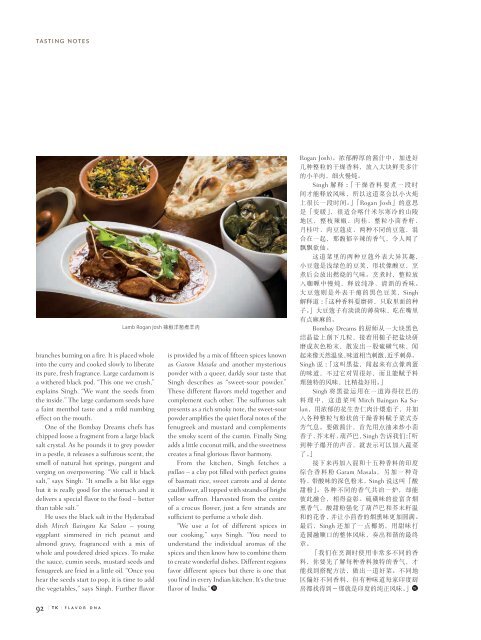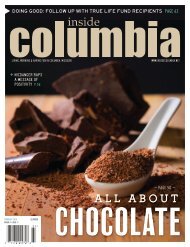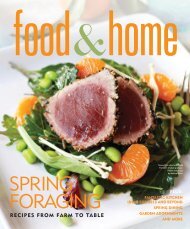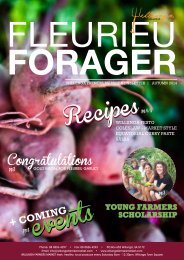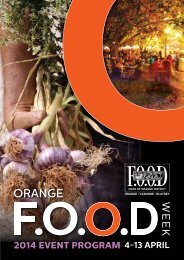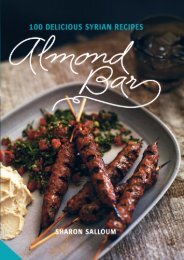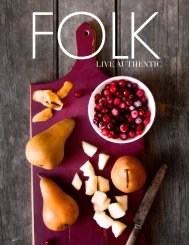Tasting Kitchen
Welcome to Tasting Kitchen. Season’s Greetings – or should I say Seasonings Greetings! This holiday TK issue is full of spices and flavorings. We talk to four talented and ambitious chefs about the flavor profile – or Flavor DNA – of dishes from India, Sichuan, Vietnam and the Isaan region of Thailand. Think cardamom, black salt and saffron, red peppercorns, red chilies and green chilies, dill, Kaffir lime, lemongrass, coriander, galangal and turmeric. We take a look at spices in history, and how even back in the Middle Ages savvy marketers knew the value of a good story. Spice merchants claimed that birds used cinnamon sticks to make giant nests in the cliffs above beaches in India, which “cinnamon hunters” then plotted to obtain. Today India is still associated with the world’s best spices. In this issue, for our first Tasting Destinations feature, TK’s Director of Photography David Hartung and Senior Writer Lucy Morgan traveled to Old Delhi to visit the world’s largest spice market and to New Delhi to visit one of the world’s top restaurants for modern Indian cuisine. One of our featured wines is the peppery Austrian Grüner Veltliner. We also talk to a New Zealand Wine Master about what makes great wine great, and to a leading French Champagne Chef de Cave about the value of patience and restraint. There are also some crabs running loose in the issue. A master chef in Macau shares his recipe for Quinoa Lobster Salad while five more from Hong Kong and Singapore share their favorite crab dishes and culinary musings. Happy Holidays,
Welcome to Tasting Kitchen.
Season’s Greetings – or should I say
Seasonings Greetings!
This holiday TK issue is full of spices and
flavorings.
We talk to four talented and ambitious
chefs about the flavor profile – or Flavor DNA
– of dishes from India, Sichuan, Vietnam and
the Isaan region of Thailand. Think cardamom,
black salt and saffron, red peppercorns, red
chilies and green chilies, dill, Kaffir lime,
lemongrass, coriander, galangal and turmeric.
We take a look at spices in history, and
how even back in the Middle Ages savvy marketers knew the value of a good story.
Spice merchants claimed that birds used cinnamon sticks to make giant nests in the
cliffs above beaches in India, which “cinnamon hunters” then plotted to obtain.
Today India is still associated with the world’s best spices. In this issue, for
our first Tasting Destinations feature, TK’s Director of Photography David Hartung
and Senior Writer Lucy Morgan traveled to Old Delhi to visit the world’s largest
spice market and to New Delhi to visit one of the world’s top restaurants for modern
Indian cuisine.
One of our featured wines is the peppery Austrian Grüner Veltliner. We also
talk to a New Zealand Wine Master about what makes great wine great, and to a
leading French Champagne Chef de Cave about the value of patience and restraint.
There are also some crabs running loose in the issue. A master chef in Macau
shares his recipe for Quinoa Lobster Salad while five more from Hong Kong and
Singapore share their favorite crab dishes and culinary musings.
Happy Holidays,
Create successful ePaper yourself
Turn your PDF publications into a flip-book with our unique Google optimized e-Paper software.
tasting notes<br />
branches burning on a fire. It is placed whole<br />
into the curry and cooked slowly to liberate<br />
its pure, fresh fragrance. Large cardamom is<br />
a withered black pod. “This one we crush,”<br />
explains Singh. “We want the seeds from<br />
the inside.” The large cardamom seeds have<br />
a faint menthol taste and a mild numbing<br />
effect on the mouth.<br />
One of the Bombay Dreams chefs has<br />
chipped loose a fragment from a large black<br />
salt crystal. As he pounds it to grey powder<br />
in a pestle, it releases a sulfurous scent, the<br />
smell of natural hot springs, pungent and<br />
verging on overpowering. “We call it black<br />
salt,” says Singh. “It smells a bit like eggs<br />
but it is really good for the stomach and it<br />
delivers a special flavor to the food – better<br />
than table salt.”<br />
He uses the black salt in the Hyderabad<br />
dish Mirch Baingan Ka Salan – young<br />
eggplant simmered in rich peanut and<br />
almond gravy, fragranced with a mix of<br />
whole and powdered dried spices. To make<br />
the sauce, cumin seeds, mustard seeds and<br />
fenugreek are fried in a little oil. “Once you<br />
hear the seeds start to pop, it is time to add<br />
the vegetables,” says Singh. Further flavor<br />
Lamb Rogan Josh 辣 椒 洋 葱 煮 羊 肉<br />
is provided by a mix of fifteen spices known<br />
as Garam Masala and another mysterious<br />
powder with a queer, darkly sour taste that<br />
Singh describes as “sweet-sour powder.”<br />
These different flavors meld together and<br />
complement each other. The sulfurous salt<br />
presents as a rich smoky note, the sweet-sour<br />
powder amplifies the quiet floral notes of the<br />
fenugreek and mustard and complements<br />
the smoky scent of the cumin. Finally Sing<br />
adds a little coconut milk, and the sweetness<br />
creates a final glorious flavor harmony.<br />
From the kitchen, Singh fetches a<br />
pullao – a clay pot filled with perfect grains<br />
of basmati rice, sweet carrots and al dente<br />
cauliflower, all topped with strands of bright<br />
yellow saffron. Harvested from the centre<br />
of a crocus flower, just a few strands are<br />
sufficient to perfume a whole dish.<br />
“We use a lot of different spices in<br />
our cooking,” says Singh. “You need to<br />
understand the individual aromas of the<br />
spices and then know how to combine them<br />
to create wonderful dishes. Different regions<br />
favor different spices but there is one that<br />
you find in every Indian kitchen. It’s the true<br />
flavor of India.”<br />
Rogan Josh)。 浓 郁 醇 厚 的 酱 汁 中 , 加 进 好<br />
几 种 整 粒 的 干 燥 香 料 , 放 入 大 块 鲜 美 多 汁<br />
的 小 羊 肉 , 细 火 慢 炖 。<br />
Singh 解 释 :「 干 燥 香 料 要 煮 一 段 时<br />
间 才 能 释 放 风 味 , 所 以 这 道 菜 会 以 小 火 炖<br />
上 很 长 一 段 时 间 。」「Rogan Josh」 的 意 思<br />
是 「 变 暖 」, 很 适 合 喀 什 米 尔 寒 冷 的 山 陵<br />
地 区 , 整 枝 辣 椒 、 肉 桂 、 整 粒 小 茴 香 籽 、<br />
月 桂 叶 、 肉 豆 蔻 皮 、 两 种 不 同 的 豆 蔻 , 混<br />
合 在 一 起 , 那 馥 郁 辛 辣 的 香 气 , 令 人 闻 了<br />
飘 飘 欲 仙 。<br />
这 道 菜 里 的 两 种 豆 蔻 外 表 大 异 其 趣 ,<br />
小 豆 蔻 是 浅 绿 色 的 豆 荚 , 形 状 像 酸 豆 , 烹<br />
煮 后 会 放 出 燃 烧 的 气 味 。 烹 煮 时 , 整 粒 放<br />
入 咖 喱 中 慢 炖 , 释 放 纯 净 、 清 新 的 香 味 。<br />
大 豆 蔻 则 是 外 表 干 瘪 的 黑 色 豆 荚 ,Singh<br />
解 释 道 :「 这 种 香 料 要 磨 碎 , 只 取 里 面 的 种<br />
子 。」 大 豆 蔻 子 有 淡 淡 的 薄 荷 味 , 吃 在 嘴 里<br />
有 点 麻 麻 的 。<br />
Bombay Dreams 的 厨 师 从 一 大 块 黑 色<br />
结 晶 盐 上 削 下 几 粒 , 接 着 用 槌 子 把 盐 块 研<br />
磨 成 灰 色 粉 末 , 散 发 出 一 股 硫 磺 气 味 , 闻<br />
起 来 像 天 然 温 泉 , 味 道 相 当 刺 激 , 近 乎 刺 鼻 。<br />
Singh 说 :「 这 叫 黑 盐 , 闻 起 来 有 点 像 鸡 蛋<br />
的 味 道 , 不 过 它 对 胃 很 好 , 而 且 能 赋 予 料<br />
理 独 特 的 风 味 , 比 精 盐 好 用 。」<br />
Singh 将 黑 盐 运 用 在 一 道 海 得 拉 巴 的<br />
料 理 中 , 这 道 菜 叫 Mirch Baingan Ka Salan,<br />
用 浓 郁 的 花 生 杏 仁 肉 汁 煨 茄 子 , 并 加<br />
入 各 种 整 粒 与 粉 状 的 干 燥 香 料 赋 予 菜 式 芬<br />
芳 气 息 。 要 做 酱 汁 , 首 先 用 点 油 来 炒 小 茴<br />
香 子 、 芥 末 籽 、 葫 芦 巴 ,Singh 告 诉 我 们 :「 听<br />
到 种 子 爆 开 的 声 音 , 就 表 示 可 以 加 入 蔬 菜<br />
了 。」<br />
接 下 来 再 加 入 混 和 十 五 种 香 料 的 印 度<br />
综 合 香 料 粉 Garam Masala, 另 加 一 种 奇<br />
特 、 带 酸 味 的 深 色 粉 末 ,Singh 说 这 叫 「 酸<br />
甜 粉 」。 各 种 不 同 的 香 气 共 冶 一 炉 , 却 能<br />
彼 此 融 合 , 相 得 益 彰 。 硫 磺 味 的 盐 富 含 烟<br />
熏 香 气 , 酸 甜 粉 强 化 了 葫 芦 巴 和 芥 末 籽 温<br />
和 的 花 香 , 并 让 小 茴 香 的 烟 熏 味 更 加 圆 满 。<br />
最 后 ,Singh 还 加 了 一 点 椰 奶 , 用 甜 味 打<br />
造 圆 融 顺 口 的 整 体 风 味 , 奏 出 和 谐 的 最 终<br />
章 。<br />
「 我 们 在 烹 调 时 使 用 非 常 多 不 同 的 香<br />
料 , 你 要 先 了 解 每 种 香 料 独 特 的 香 气 , 才<br />
能 找 到 搭 配 方 法 , 做 出 一 道 好 菜 。 不 同 地<br />
区 偏 好 不 同 香 料 , 但 有 种 味 道 每 家 印 度 厨<br />
房 都 找 得 到 - 那 就 是 印 度 的 纯 正 风 味 。」<br />
92<br />
| TK | flavor dna


